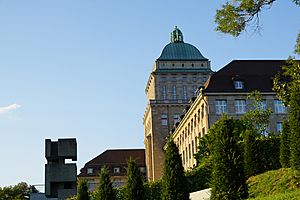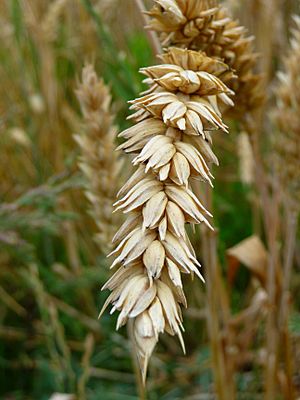Catherine Feuillet facts for kids
Quick facts for kids
Catherine Feuillet
|
|
|---|---|
| Born |
Catherine Feuillet
July 1965 (age 60) Orléans, France
|
| Nationality | French |
| Alma mater | Federal Institute for Agroecology in Zurich |
| Occupation | Geneticist and Molecular Biologist |
| Known for | Sequencing chromosome 3B on the wheat genome |
| Awards | Prix Foulon, Trophée de la Femme, Chevalier of the Legion of Honour, Jean Dufrenoy Prize from the Académie d'Agriculture of France |
Catherine Feuillet (born July 1965) is a French geneticist and molecular biologist. She is currently the Chief Scientific Officer at Inari Agriculture, a company that works on improving crops. Dr. Feuillet is famous for her important work in mapping and sequencing the wheat genome. This means she helped figure out the complete genetic code of wheat, which is a huge step for agriculture.
She earned her PhD in plant molecular biology, studying genes in eucalyptus trees. Later, she focused on wheat, researching how to make it resistant to diseases. She even found the first gene in wheat that helps it fight off a common fungal disease called leaf rust. In 2004, she became a research director in France, leading big projects on wheat genetics.
In 2008, Dr. Feuillet and her team successfully mapped chromosome 3B, which is the largest chromosome in wheat. By 2014, they had fully sequenced this chromosome. They also helped create the first complete reference sequence of the entire wheat genome with a group called the International Wheat Genome Sequencing Consortium (IWGSC). She was a co-founder and co-chair of the IWGSC for many years. Her work has earned her several awards, including the prestigious Chevalier of the Legion of Honour.
Contents
Early Life and Education
Catherine Feuillet was born in Orléans, a city about 130 kilometers (80 miles) south of Paris, France. She studied plant molecular biology at university in Toulouse. In 1993, she earned her doctorate degree from Paul Sabatier University. Her research focused on genes involved in how wood forms in eucalyptus trees.
From 1994 to 1997, she did more research at the Federal Institute for Agroecology in Zürich, Switzerland. There, she worked on creating tools to help breed wheat that could resist fungal diseases. During this time, she started her work on wheat genetics. She continued to develop projects on disease resistance genes and comparative genomics (comparing genes between different species) in wheat and barley at the University of Zurich.
"On me dit que je fais peur aux gens en parlant de sélection de gènes... Mais je ne fais que ce que font les fermiers depuis dix mille ans! Sauf qu’ils le faisaient sans le savoir, par croisements. Maintenant, nous, on veut savoir."
"They tell me I scare people by talking about gene selection .... But I only do what farmers have been doing for ten thousand years. Except that they did it, without knowing it, by cross-breeding. Now we want to know [what we are doing]."
Important Research and Awards
In 2004, Dr. Feuillet joined the Institut National de la Recherche Agronomique (INRA) in Clermont-Ferrand, France. She became a research director there. In 2005, she helped start the International Wheat Genome Sequencing Consortium (IWGSC). This was a huge international project to create a high-quality map of the bread wheat genome. This was a big challenge because the wheat genome is five times larger than the human genome!
Also in 2005, she helped create and became the chair of the European Triticeae Genomics Initiative (ETGI). This group worked to coordinate research on wheat, barley, and rye in Europe. From 2008 to 2012, she led a European project called "TriticeaeGenome." This project involved 17 partners from different countries.
In 2008, Dr. Feuillet's team published their findings in the journal Science. They showed the first map of wheat chromosome 3B, which is the largest of wheat's 21 chromosomes. That same year, she joined another group called the International Triticeae Mapping Initiative (ITMI) to help plan research projects. In 2009, she started and led "Breedwheat," a large project in France. This project aimed to make French wheat breeding more competitive and meet demands for sustainable and safe food production.
Dr. Feuillet has received many honors for her work. On November 24, 2009, she received the Prix Foulon from the French Academy of Sciences. That same year, she also won the gold Trophée de la Femme for her research. On September 10, 2010, she received the insignia of Chevalier of the Legion of Honour from the INRA.
In 2011, she joined the Wheat Initiative, which was created by the G20 countries to improve global wheat production. That same year, she became a Fellow of the American Association for the Advancement of Science. In 2012, she received the Jean Dufrenoy Prize from the Académie d'Agriculture of France.
After her team at INRA finished sequencing chromosome 3B, a major achievement published in Science magazine, Dr. Feuillet joined Bayer CropScience. There, she led the Trait Research Department, focusing on finding genes to improve crops like soybean, cotton, canola, and wheat.
Understanding the Wheat Genome
When Dr. Feuillet joined INRA in 2004, she started working on sequencing the bread wheat genome. This genome is huge, with 21 chromosomes and a total size of about 16 billion DNA base pairs. Her goal was to understand chromosome 3B, which alone is 1 billion base pairs long. That's as big as the entire soybean genome and more than twice the size of the entire rice genome!
At first, it was very hard to sequence the whole wheat genome because it has so many repeated DNA sequences. Dr. Feuillet and her team were the first to create a physical map of chromosome 3B. This map was published in Science in 2008. This important step helped other teams map the other 20 chromosomes.
In 2014, Dr. Feuillet and her team published the complete reference sequence of chromosome 3B. This showed how the more than 8,000 genes are arranged along the chromosome. It also helped scientists better understand how large, complex genomes like wheat are organized and how they have changed over time. The draft sequence of all 21 chromosomes allowed scientists to identify 124,201 genes. These sequences have helped scientists find genes faster, develop new genetic markers, and use precise breeding methods to improve wheat more quickly.
In 2016, a company called NRGene made a breakthrough in sequencing highly repetitive DNA. This allowed the IWGSC to combine different sequencing methods to create a high-quality reference sequence of the bread wheat genome. This was published in Science in 2018. Since then, many studies have used this reference sequence, proving how useful it is. This fulfilled the vision that Dr. Feuillet and her colleagues at the IWGSC had back in 2005.
Sequencing the wheat genome is very important for farmers and people around the world. Wheat provides more than 20% of all the calories people eat globally. As the world's population grows, we need more wheat. However, wheat production has been slowing down. The demand for wheat is expected to increase by 70% by 2050. Having the wheat genome sequence is an amazing tool for scientists. It helps them improve wheat and make it better able to handle climate change. It also helps produce wheat in a way that is good for the environment.
Current Research
Dr. Feuillet now leads the science team at Inari Agriculture as their Chief Scientific Officer. Her team includes about 70 scientists in Belgium, Massachusetts, and Indiana. They work on finding specific parts of plant genomes to change. They are also developing special tools for "genome editing." This technology allows them to precisely change genes in major crops like corn, soybean, wheat, and tomato. Their goal is to bring plant breeding into a new era. They want to quickly create hundreds of new plant varieties that grow best in their local environments while using fewer natural resources.



